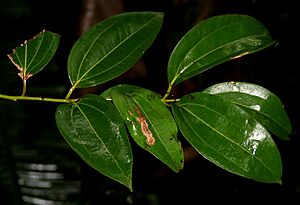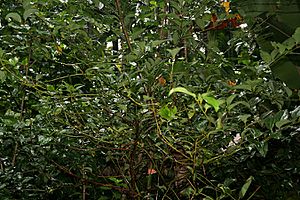Indian bay leaf facts for kids
Quick facts for kids Indian bay leaf |
|
|---|---|
 |
|
| Semi-dried Indian bay leaves | |
| Scientific classification | |
| Genus: |
Cinnamomum
|
| Species: |
tamala
|
| Synonyms | |
|
|
Cinnamomum tamala, also called Indian bay leaf, is a special tree. People also know it as tejpat, Malabar leaf, or Indian cassia. This tree belongs to the Lauraceae family.
You can find the Indian bay leaf tree growing naturally in countries like India, Bangladesh, Nepal, Bhutan, and China. It can grow very tall, sometimes up to 20 meters (about 65 feet).
The leaves of this tree smell a bit like cloves and taste a little peppery. People use them in cooking and also for traditional medicine. Long ago, people believed these leaves were the main source of a famous medicinal plant called malabathrum.
Contents
What Makes Indian Bay Leaf Special?
The leaves of the Indian bay leaf tree have many different names depending on where you are. For example, in Hindi, they are called tējapattā. In Bengali, they are tejpata. In Malayalam, they are vazhanayila.
These leaves are very popular in the food of India, Nepal, and Bhutan. They are especially important in the rich Moghul cuisine of North India and Nepal. You can also find them in a special herbal tea called tsheringma in Bhutan.
In Kerala, a state in India, these leaves are often used to wrap a sweet dish called Kumbilappam. This gives the dumplings their unique and delicious flavor.
Sometimes, people get Indian bay leaves mixed up with regular bay leaves from the Mediterranean. But they are quite different!
- Regular bay leaves are shorter and light green. They have only one main vein down the middle.
- Indian bay leaves are about twice as long and wider. They are usually olive green and have three clear veins running down their length.
There are five different kinds of tejpat leaves. They give food a strong smell, like cinnamon. Regular bay leaves, however, smell more like pine and lemon.

What Does It Smell Like?
The special smell of Indian bay leaf comes from natural chemicals inside it. Some of these are:
- Beta-caryophyllene
- Linalool
- Caryophyllene oxide
- Eugenol
How Is It Used?
The leaves are mostly used in cooking to add flavor. Sometimes, the bark of the tree is also used in cooking. However, it is not as popular as true cinnamon or cassia.
Where Did the Name Come From?
The word "Malabar" used to refer to the western coast of Southern India. This area is now mostly the state of Kerala. The word mala or malaya means "mountain" in Tamil, Malayalam, and Sanskrit languages.
The old word "malabathrum" is believed to come from the Sanskrit word tamālapattram. This means "dark-tree leaves."
Other Similar Plants
Indian bay leaf is related to other plants in the Cinnamomum family. Some of these include:
See also
 In Spanish: Cinnamomum tamala para niños
In Spanish: Cinnamomum tamala para niños



